In Oriental medicine, licorice is considered a precious medicinal herb that can be used to treat many diseases. However, few people know what licorice is, how to distinguish the types and how to use or use it?
Table of Contents
Licorice is a medium-sized, sweet, non-toxic drug, which is referred to in the three main sutras as Heart, Waste and Pi Vi. The uses of licorice have been verified through remedies in traditional medicine as well as modern scientific studies.
What is licorice?
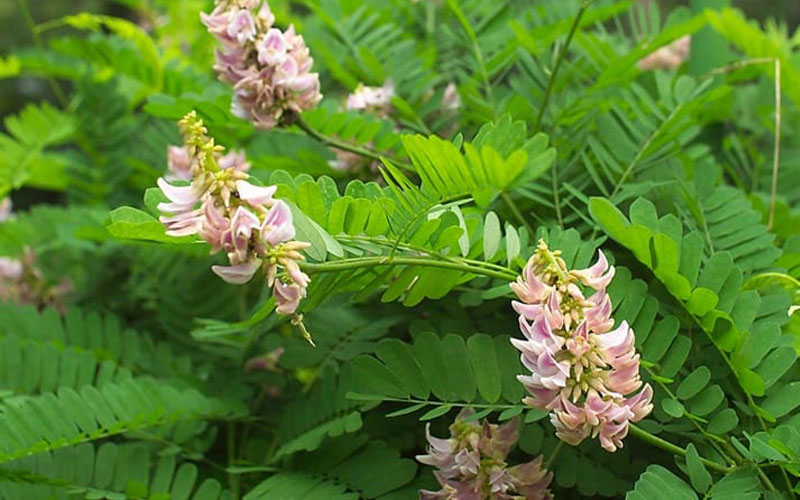
Licorice is a flowering plant native to Asia, legume (Butterfly family) scientifically known as Glycyrrhiza uralensis. In Vietnam, depending on the region, there will be different names such as licorice birth, national elder, …
How to prepare licorice
Usually people will use the stem and roots to make medicine. Depending on the type of processing, the method will be different. Herbs: Wash the roots, then cut them into slices and then dry or dry them.
Licorice powder: Scrape off the outer skin and cut into pieces, dry and then grind into powder
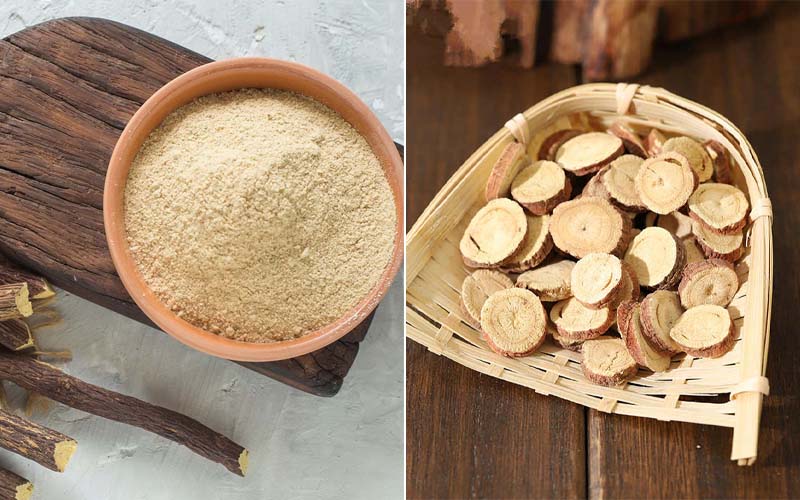
Licorice powder: This method also shaves off all the outer skin, then soak in wine for about 1 hour, then incubate for 12 hours, then cut it thinly and dry it.
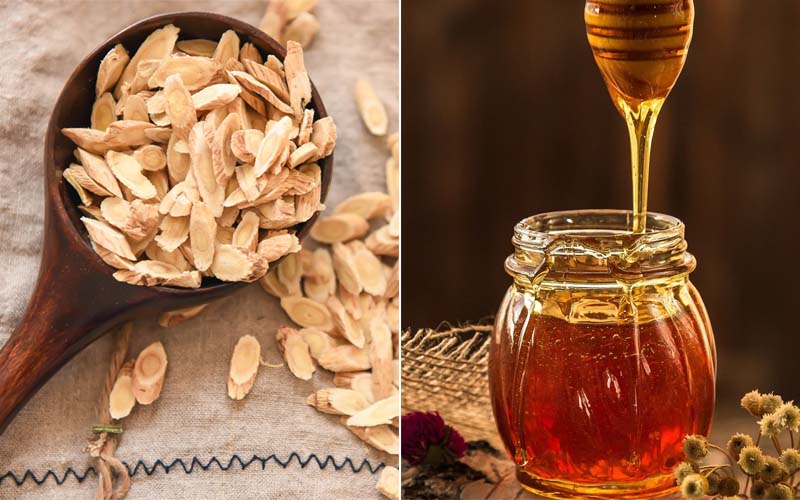
Licorice injection: Infused with honey for dried licorice (According to the ratio of 1kg of licorice, 200mg of honey + 200ml of boiling water). Then let it dry until the licorice smells good.
How to distinguish the types of licorice?
Ground licorice (male licorice): Grows a lot in the northern midland and mountainous provinces or the southern plains, usually 0.4 – 0.7 m high from the ground. Licorice roots are quite large and will often grow in bunches, if the plant is old, the stem will turn to wood at the base.

The leaves of male licorice have the characteristic of growing singly, symmetrically or in 3-leaf rings. In the summer, flowers will grow from the interstitial leaves, white, and the fruit will be spherical, containing many small seeds inside.
This variety can be harvested all year round, will usually give off a light aroma and a slightly bitter taste then turn sweet. People will often use male licorice to clear heat, detoxify, diuretic, …
Northern licorice: This type will focus on developing underground roots, which can penetrate up to 2m across. The upper stem is a rather weak herbaceous plant, unlike the male licorice, the leaves of this type are compound leaves, oval in shape.
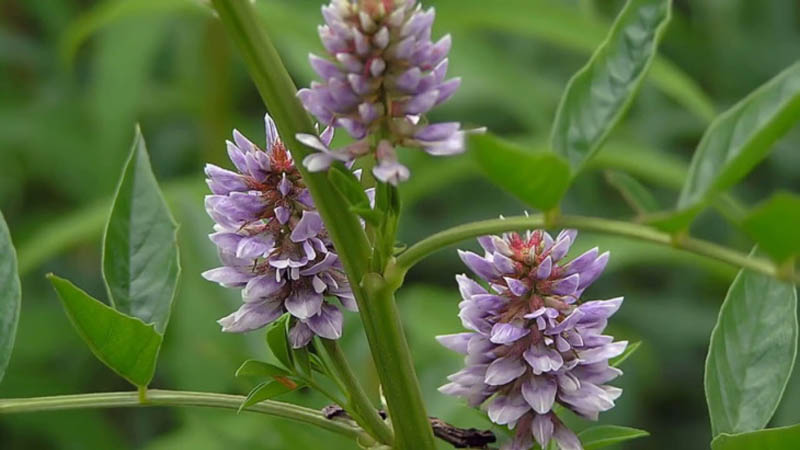
Licorice rope (lime limb): Licorice rope belongs to the vine, quite fibrous and small branches. The leaves are shaped like feathers, growing in beautiful ruby clusters.
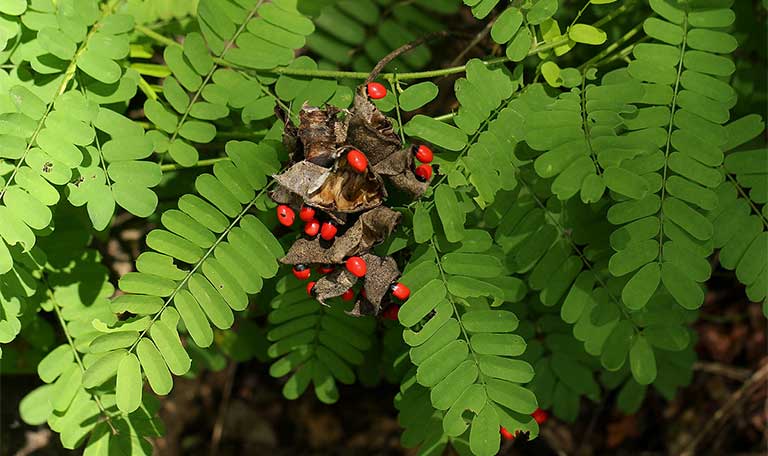
Uses of licorice
- For health
Some uses of licorice in Oriental medicine such as being used as a conduction drug, treating sore throats, coughs, lots of phlegm, … or digestive diseases, ulcers of the stomach and duodenum.
Besides, licorice also has the effect of detoxifying, regulating the effects of drugs.
In licorice also contains the active ingredient staphylococcus aureus, a substance with antibacterial ability to help improve impetigo, folliculitis, …
2. For beauty
Not only helps to treat skin problems, but licorice is also used by many women as a mask to treat acne because it contains glabridin.
According to a clinical study published in the Journal of Agricultural and Food Chemistry, glabridin has the ability to inhibit the enzyme tyrosinase, an enzyme that produces melanin that causes skin pigmentation, by up to 50% without harming the skin. .
Therefore, licorice extract can effectively treat post-inflammatory hyperpigmentation and repair post-acne damage.
If you are looking for a Licorice from nature supplier to cooperate with. Please contact below:
VietDelta Corp.
Address: 20/5 Dinh Bo Linh, Binh Thanh, Ho Chi Minh.
whatsapp: +84364772308
Email: info@vdelta.com.vn
We are ready to meet all your requirements in terms of quantity and quality.
We still have a lot of products for you to check out.
Thank you.






Hosea
I’ve recently started a blog, the info you provide on this website has
helped me greatly. Thank you for all of your time & work.
Here is my page pmp certification (Hosea)
опрессовка отопительной системы
My spouse and I stumbled over here different page and thought I may as well check things out.
I like what I see so now i am following you. Look forward to going over your web page
repeatedly.
Чеки на гостиницу в Казане
Great goods from you, man. I’ve understand your stuff previous to and you are just too fantastic.
I really like what you have acquired here, really like what
you are saying and the way in which you say it.
You make it entertaining and you still care for to keep it sensible.
I can’t wait to read far more from you. This is really a terrific website.
body tape for breast
Can I simply say what a relief to uncover somebody who
truly understands what they are discussing on the
web. You actually know how to bring an issue to light and make it
important. More people really need to look at this and understand this side of your story.
I was surprised you aren’t more popular given that you
definitely have the gift.
Гостиничные чеки в Казани
What a stuff of un-ambiguity and preserveness of precious
knowledge on the topic of unpredicted emotions.
bob tape
This excellent website really has all of the information and facts I needed about this
subject and didn’t know who to ask.
Ernesto
Excellent goods from you, man. I have understand your stuff previous to and you are just too
fantastic. I really like what you have acquired here, certainly like what yyou are saying and the way iin which you
say it. You make it entertaining and youu still czre for to keep
it sensible. I can not wait to read far molre from you.
This is really a tremendoys web site.
my web blog: cpa exam anxiety (Ernesto)
Suecub
stromectol tab 3mg
Estebanduary
buy propecia online europe
Гостиничные чеки в Екатеринбурге
I don’t even understand how I finished up here, however I thought this put up was
great. I don’t understand who you’re however definitely you are going to a well-known blogger in case you aren’t already.
Cheers!
лечение кариеса
I love what you guys are up too. This type of clever work and reporting!
Keep up the good works guys I’ve included you guys to our blogroll.
накрутка подписчиков в yappy
WOW just what I was looking for. Came here by searching for
удаление пигментных пятен на лице
fantastic points altogether, you just won a new reader.
What would you recommend about your put up that you made some days in the past?
Any positive?
удаление пигментных пятен Минск
I’m gone to say to my little brother, that he should also
pay a quick visit this weblog on regular basis to obtain updated from hottest information.
увеличение губ минск
Hi there to every one, it’s in fact a nice for me to go
to see this site, it contains precious Information.
http://nastroyke-info.ru/
You need to take part in a contest for one of the greatest blogs on the web.
I most certainly will highly recommend this web site!
Хай Дэй скачать на компьютер
This website was… how do I say it? Relevant!!
Finally I have found something which helped me. Many thanks!
просмотры в яппи
What a information of un-ambiguity and preserveness of valuable know-how concerning unexpected emotions.
Hay day скачать на компьютер
Magnificent goods from you, man. I’ve be aware your stuff prior to and you are just too magnificent.
I really like what you’ve received here, really like what
you are saying and the best way by which you assert it.
You make it entertaining and you continue to take care of to keep it smart.
I cant wait to learn much more from you. That is actually
a wonderful site.
Хай Дэй скачать на компьютер
Heya i’m for the first time here. I came across this board and I find It truly
useful & it helped me out much. I hope to give something
back and aid others like you aided me.
http://nastroyke-info.ru/
I’m very pleased to discover this great site. I wanted to thank
you for ones time for this wonderful read!! I definitely loved every little bit of it and I have you book
marked to check out new information in your site.
https://artisaninfo.ru/
I just like the valuable information you supply to your articles.
I’ll bookmark your blog and check once more right here regularly.
I’m fairly sure I will be informed lots of new stuff right here!
Good luck for the following!
http://masterok-tut.ru/
Your mode of describing everything in this paragraph is truly pleasant, every one can effortlessly know it, Thanks a lot.
увеличить губы гиалуроновой кислотой
Thanks , I have just been looking for info approximately this subject for a while and yours is the greatest I’ve discovered till now.
But, what about the bottom line? Are you positive about
the source?
sadovnikinfo.ru
If you are going for finest contents like myself, only
go to see this website everyday as it presents feature contents, thanks
увеличение губ минск
Hello, i think that i saw you visited my site so i came to
go back the want?.I am attempting to to find things to improve my website!I assume its
adequate to use some of your ideas!!
https://nakrutka-prosmotrov-yappy-pr2.online/
I think this is among the most vital information for me.
And i’m glad reading your article. But should remark on some general things, The site style is perfect, the articles is really nice : D.
Good job, cheers
https://nakrutka-prosmotrov-yappy-pr2.ru/
Just desire to say your article is as amazing. The clarity in your submit is simply nice and i could suppose you are
an expert on this subject. Well with your permission allow me to grasp your RSS
feed to keep up to date with forthcoming post.
Thank you a million and please carry on the enjoyable work.
лечение кариеса
After looking over a few of the articles on your web page, I truly like your technique of blogging.
I added it to my bookmark website list and will be checking back soon. Please visit my website too and tell me your opinion.
монтаж кондиционера Минск
Howdy! Do you use Twitter? I’d like to follow you if that would be ok.
I’m definitely enjoying your blog and look forward to new posts.
кариес зубов лечение
Thank you a bunch for sharing this with all folks you really understand
what you’re speaking about! Bookmarked. Please also visit my
web site =). We can have a link exchange contract between us
http://infocars24.ru/
My spouse and I absolutely love your blog and find most of
your post’s to be just what I’m looking for.
Do you offer guest writers to write content for you? I wouldn’t mind producing a post or elaborating on some of the subjects you write concerning here.
Again, awesome blog!
http://cb23.ru/
Howdy! This post could not be written much better!
Looking at this article reminds me of my previous roommate!
He continually kept preaching about this. I’ll send this information to
him. Pretty sure he’ll have a good read. Many thanks for sharing!
Гостиничные чеки купить в Москве
Hi to every one, it’s truly a nice for me to pay a quick visit this website,
it consists of helpful Information.
http://yes-cars.ru/
Howdy! This post could not be written any better! Reading this
post reminds me of my previous room mate! He always kept chatting about
this. I will forward this post to him. Fairly certain he will have a good read.
Many thanks for sharing!
карта из дерева на стену с подсветкой
Spot on with this write-up, I really believe this website needs much more attention.
I’ll probably be returning to read more, thanks for
the advice!
карта мира из дерева
Very good website you have here but I was curious about if you knew of any message boards that cover the same topics discussed
here? I’d really like to be a part of community where I can get feedback from other experienced individuals that share the same interest.
If you have any recommendations, please let me know.
Thanks!
карта мира деревянная на стену с подсветкой
Great post. I was checking continuously this blog and I’m impressed!
Extremely useful information specially the last part :
) I care for such info much. I was seeking this certain information for a very long time.
Thank you and best of luck.
карта мира деревянная на стену с подсветкой
whoah this weblog is fantastic i really like studying your articles.
Stay up the great work! You already know, lots
of persons are hunting round for this info, you could
help them greatly.
http://hitmind.ru/
Greetings I am so delighted I found your webpage, I really found you by mistake, while I was browsing on Digg for something else,
Anyhow I am here now and would just like to say thanks a lot for a incredible
post and a all round entertaining blog (I also love the theme/design), I
don’t have time to read through it all at the minute but
I have bookmarked it and also added in your RSS feeds, so when I have
time I will be back to read much more, Please do keep up the fantastic b.
снять место для хранения вещей
My spouse and I stumbled over here coming from a different website
and thought I should check things out. I like what I see so now i am following you.
Look forward to looking over your web page for a
second time.
хранение техники на складе
Hi, all the time i used to check blog posts here early in the break
of day, as i enjoy to find out more and more.
хранение бытовой техники
Excellent web site you have here.. It’s difficult to find quality writing like yours
these days. I truly appreciate individuals like you!
Take care!!
http://mydwg.ru/
Wow that was strange. I just wrote an extremely long comment but after I clicked submit my comment didn’t show up.
Grrrr… well I’m not writing all that over again. Regardless, just wanted to say wonderful blog!
вывести тату минск
I always emailed this website post page to all my friends,
since if like to read it next my contacts will too.
http://remontiruj-info.ru/
I every time spent my half an hour to read this webpage’s
articles or reviews all the time along with a cup of coffee.
удаление тату минск
It’s very effortless to find out any topic on net as compared to textbooks, as I found this
article at this web page.
http://infostroitely.ru/
For latest information you have to visit world wide web and on world-wide-web I found
this web page as a best web site for most recent
updates.
http://avto-zhelezo.ru/
Your means of explaining everything in this post is really pleasant,
all be able to without difficulty understand it, Thanks a lot.
Хранение вещей Минск
It’s a pity you don’t have a donate button! I’d definitely
donate to this outstanding blog! I guess for now i’ll settle for book-marking and adding your RSS feed to my Google account.
I look forward to new updates and will talk about this blog with my Facebook group.
Chat soon!
сервис по хранению вещей минск
Hello, I check your blog on a regular basis. Your story-telling style is
awesome, keep it up!
Kieu My
Thank you very much, your compliments will be the motivation for me to try to write more useful blogs
http://stroitely-tut.ru/
whoah this weblog is great i love reading your articles. Keep up the good work!
You realize, many persons are hunting around for this information, you could help them greatly.
http://masakra.ru/
What’s up everybody, here every person is sharing such familiarity, therefore it’s good to read this weblog, and I used to pay a visit this web site daily.
http://masterstroy-info.ru/
This text is worth everyone’s attention. Where
can I find out more?
http://ivistroy.ru/
Pretty section of content. I just stumbled upon your weblog and in accession capital to assert that I get in fact
enjoyed account your blog posts. Any way I’ll be subscribing to your augment and even I achievement
you access consistently fast.
сервис хранения вещей
I’m really enjoying the design and layout of your website.
It’s a very easy on the eyes which makes it much more enjoyable for me to come here
and visit more often. Did you hire out a designer to create your theme?
Superb work!
https://vyvod-iz-zapoya-minsk.online/
Amazing! This blog looks just like my old one! It’s on a completely different subject but it has pretty
much the same page layout and design. Superb choice of colors!
http://vopros-remonta-info.ru/
This is my first time pay a visit at here and i am actually pleassant to read all at single place.
https://vyvod-iz-zapoya-minsk.ru/
Hello would you mind letting me know which webhost
you’re utilizing? I’ve loaded your blog in 3 completely different web
browsers and I must say this blog loads a lot quicker then most.
Can you suggest a good web hosting provider at a reasonable price?
Many thanks, I appreciate it!
http://tut-proremont.ru/
whoah this blog is excellent i really like studying your articles.
Stay up the good work! You know, lots of persons are searching round for this info, you can aid them greatly.
http://otremontirowal.ru/
Hey There. I discovered your blog using msn.
This is a very neatly written article. I will make sure to bookmark
it and come back to learn extra of your useful info.
Thanks for the post. I will certainly comeback.
http://sad-ogorod-info.ru/
Very great post. I just stumbled upon your weblog and
wished to say that I have truly loved surfing around your blog posts.
After all I will be subscribing on your rss feed
and I hope you write again very soon!
http://vgryadkah.ru/
Hey there! Someone in my Myspace group shared this site with
us so I came to look it over. I’m definitely loving the information. I’m book-marking and will be tweeting this to my followers!
Excellent blog and fantastic style and design.
Suecub
how to get amoxicillin over the counter
удаление тату минск
It’s a pity you don’t have a donate button! I’d definitely donate to this excellent blog!
I guess for now i’ll settle for bookmarking and adding your RSS
feed to my Google account. I look forward to new updates
and will share this blog with my Facebook group.
Chat soon!
http://pro-sadovnik.ru/
Thanks for any other magnificent article. Where else may
just anybody get that kind of information in such a perfect manner of writing?
I’ve a presentation subsequent week, and I’m at the search for such information.
yes-dacha.ru
My spouse and I stumbled over here coming from a different page and thought I may as well check things out. I like what I see so now i’m following you. Look forward to looking at your web page again.
remont-master-info.ru
It is not my first time to visit this web site, i am visiting this web site dailly and take nice data from here everyday.
smartremstroy.ru
Hello there, just became aware of your blog through Google, and found that it is really informative. I’m gonna watch out for brussels. I will appreciate if you continue this in future. A lot of people will be benefited from your writing. Cheers!
delaremontnika.ru
Thanks in favor of sharing such a nice thought, piece of writing is good, thats why i have read it fully
nemasterok.ru
Someone necessarily lend a hand to make seriously articles I would state. This is the first time I frequented your web page and so far? I amazed with the research you made to create this actual submit amazing. Magnificent process!
remstrdom.ru
It’s nearly impossible to find well-informed people about this topic, but you sound like you know what you’re talking about! Thanks
glavdachnik.ru
I am truly pleased to read this blog posts which contains plenty of helpful data, thanks for providing these data.
glavdachnik.ru
This web site definitely has all of the information I wanted about this subject and didn’t know who to ask.
infoda4nik.ru
Excellent blog here! Also your website loads up fast! What host are you using? Can I get your affiliate link to your host? I wish my site loaded up as fast as yours lol
ogorodkino.ru
Do you mind if I quote a couple of your posts as long as I provide credit and sources back to your site? My website is in the very same area of interest as yours and my visitors would certainly benefit from a lot of the information you present here. Please let me know if this alright with you. Many thanks!
sadovoe-tut.ru
What a data of un-ambiguity and preserveness of precious experience concerning unexpected feelings.
накрутка просмотров яппи
I love it when individuals come together and share opinions. Great website, continue the good work!
Карта мира из дерева на стену
Hello there! This is my first visit to your blog! We are a group of volunteers and starting a new initiative in a community in the same niche. Your blog provided us useful information to work on. You have done a marvellous job!
купить пуговицы Минск
First off I want to say awesome blog! I had a quick question that I’d like to ask if you don’t mind. I was curious to know how you center yourself and clear your mind before writing. I have had a hard time clearing my mind in getting my thoughts out. I do enjoy writing but it just seems like the first 10 to 15 minutes are generally wasted just trying to figure out how to begin. Any suggestions or tips? Thank you!
Прогон сайта хрумером
Hurrah! At last I got a weblog from where I be able to actually take useful data regarding my study and knowledge.
Прогон сайта хрумером
Pretty great post. I simply stumbled upon your blog and wanted to mention that I have really enjoyed browsing your blog posts. In any case I’ll be subscribing in your feed and I am hoping you write again soon!
Прогон сайта хрумером
Hi there! This post couldn’t be written any better! Reading through this post reminds me of my previous roommate! He constantly kept talking about this. I will forward this article to him. Pretty sure he will have a very good read. Thanks for sharing!
тахта угловая купить в Москве
Pretty section of content. I just stumbled upon your website and in accession capital to assert that I acquire in fact enjoyed account your blog posts. Any way I’ll be subscribing to your augment and even I achievement you access consistently rapidly.
угловая тахта с матрасом
Superb website you have here but I was curious about if you knew of any user discussion forums that cover the same topics talked about in this article? I’d really love to be a part of group where I can get advice from other knowledgeable individuals that share the same interest. If you have any recommendations, please let me know. Thank you!
угловая тахта
I like reading through a post that will make people think. Also, thanks for allowing for me to comment!
Линукс Минт
excellent issues altogether, you simply gained a emblem new reader. What would you suggest about your publish that you just made a few days in the past? Any positive?
Масла и технические жидкости в Тойота Хайлендер
Hey there! Do you know if they make any plugins to assist with SEO?
I’m trying to get my blog to rank for some targeted keywords but I’m not seeing very good gains.
If you know of any please share. Appreciate it!
этим
whoah this weblog is great i like reading your posts.
Stay up the good work! You already know, lots of individuals are looking around
for this information, you could aid them greatly.
فیلم روز
Way cool! Some very valid points! I appreciate you penning this write-up plus / the rest of the site is really good.
continue reading this
This text is priceless. When can I find out more?
получить военный билет
You made some really good points there. I looked on the web for
more information about the issue and found
most individuals will go along with your views on this web site.
https://komitetsp.ru/
Hello everyone, it’s my first pay a visit at this site, and piece of writing is actually fruitful for me, keep up posting these articles.
here
Good day! Would you mind if I share your blog with my myspace group?
There’s a lot of folks that I think would really appreciate your content.
Please let me know. Thanks
клик
Hola! I’ve been reading your weblog for a while
now and finally got the bravery to go ahead and give you a shout out from Porter Texas!
Just wanted to tell you keep up the good job!
ссылку
Wonderful blog you have here but I was curious about if you
knew of any message boards that cover the same
topics discussed here? I’d really love to be a part of online community
where I can get opinions from other experienced people
that share the same interest. If you have any suggestions, please let me know.
Many thanks!
ссылочку
First off I want to say wonderful blog! I had a quick question which I’d like
to ask if you don’t mind. I was curious to find
out how you center yourself and clear your head prior
to writing. I’ve had difficulty clearing my mind in getting my thoughts out.
I truly do take pleasure in writing however it just seems
like the first 10 to 15 minutes are generally wasted just trying to figure out how to begin. Any
ideas or tips? Thank you!
Фурнитура для вендинговых автоматов
Hi, i read your blog from time to time and i own a similar one and i was just wondering if you get a lot of spam feedback? If so how do you reduce it, any plugin or anything you can recommend? I get so much lately it’s driving me crazy so any assistance is very much appreciated.
Новости Бреста
Thank you a lot for sharing this with all people you really know what you are talking approximately! Bookmarked. Kindly also discuss with my website =). We could have a hyperlink change arrangement among us
https://dostavych.by/
Hello my loved one! I want to say that this post is amazing, nice written and include approximately all important infos. I’d like to peer more posts like this .
Dolphin Watching Tour at lovina beach
I’ve recently started a blog, the info you offer on this web site has helped me greatly. Thanks for all of your time & work. “Quit worrying about your health. It’ll go away.” by Robert Orben.
Cheap Smm Panel
Hello there! I could have sworn I’ve been to this website before but after reading through some of the post I realized it’s new to me. Anyways, I’m definitely glad I found it and I’ll be bookmarking and checking back frequently!
aparelho removedor extração de cravos
Hola! I’ve been following your blog for some time now and finally got the bravery to go ahead and give you a shout out from Dallas Texas! Just wanted to mention keep up the excellent work!
imóveis de frente para praia em west palm beach
Hello. excellent job. I did not expect this. This is a excellent story. Thanks!
tin beer signs
It is perfect time to make some plans for the future and it is time to be happy. I’ve read this post and if I could I desire to suggest you few interesting things or tips. Maybe you can write next articles referring to this article. I want to read more things about it!
find SEO company
Everyone loves what you guys are up too. This kind of clever work and coverage! Keep up the very good works guys I’ve added you guys to my own blogroll.
company SEO
Please let me know if you’re looking for a article writer for your site. You have some really good articles and I feel I would be a good asset. If you ever want to take some of the load off, I’d love to write some material for your blog in exchange for a link back to mine. Please blast me an email if interested. Many thanks!
รองพื้น
Wohh just what I was looking for, thankyou for posting.
กางเกงในคนอ้วน
It?¦s really a great and useful piece of info. I am glad that you just shared this useful info with us. Please stay us up to date like this. Thanks for sharing.
https://mobilniki.by/
Hi, I desire to subscribe for this weblog to obtain newest updates, so where can i do it please assist.
bocoran gacor slot
Good info. Lucky me I reach on your website by accident, I bookmarked it.
top up ff murah
I think other web-site proprietors should take this site as an model, very clean and great user friendly style and design, let alone the content. You are an expert in this topic!
top1toto
Hey, I think your site might be having browser compatibility issues. When I look at your blog site in Opera, it looks fine but when opening in Internet Explorer, it has some overlapping. I just wanted to give you a quick heads up! Other then that, fantastic blog!
topjitu
I have been exploring for a little bit for any high-quality articles or weblog posts on this kind of area . Exploring in Yahoo I at last stumbled upon this site. Reading this information So i am satisfied to exhibit that I have an incredibly excellent uncanny feeling I found out just what I needed. I so much indubitably will make sure to don¦t disregard this web site and provides it a glance regularly.
topjitu login
I really like your writing style, good information, appreciate it for posting :D. “Faith is a continuation of reason.” by William Adams.
kebaya4d
Perfectly pent content material, appreciate it for entropy. “You can do very little with faith, but you can do nothing without it.” by Samuel Butler.
kebaya4d
Thanks for helping out, superb information.
slot gacor 2023
Some genuinely nice and utilitarian information on this web site, also I believe the design and style has got superb features.
hoki62 slot
Neat blog! Is your theme custom made or did you download it from somewhere? A theme like yours with a few simple tweeks would really make my blog shine. Please let me know where you got your design. Appreciate it
Top Tips
Hey very cool blog!! Man .. Beautiful .. Amazing .. I’ll bookmark your site and take the feeds also…I am happy to find numerous useful info here in the post, we need work out more strategies in this regard, thanks for sharing. . . . . .
https://dedekids.pl/pl/c/Pokoj-dla-dziewczynki/160
of course like your website but you have to check the spelling on quite a few of your posts. A number of them are rife with spelling problems and I find it very troublesome to inform the truth on the other hand I?¦ll definitely come back again.
pokój dla dziewczynki
Hi, I think your site might be having browser compatibility issues. When I look at your website in Safari, it looks fine but when opening in Internet Explorer, it has some overlapping. I just wanted to give you a quick heads up! Other then that, fantastic blog!
Sport808
I envy your work, regards for all the great content.
Sport808
I gotta bookmark this website it seems invaluable very beneficial
Baixar Filmes Torrent
magnificent points altogether, you simply gained a brand new reader. What would you suggest in regards to your post that you made some days ago? Any positive?
need a cell phone hacker
Hmm it appears like your site ate my first comment (it was super long) so I guess I’ll just sum it up what I had written and say, I’m thoroughly enjoying your blog. I too am an aspiring blog writer but I’m still new to the whole thing. Do you have any recommendations for newbie blog writers? I’d definitely appreciate it.
Healing Red Light
Some truly howling work on behalf of the owner of this website , absolutely outstanding articles.
Fornecedores de Pedra Madeira Bruta
Hey There. I discovered your weblog the use of msn. That is a really well written article. I’ll make sure to bookmark it and return to read extra of your helpful information. Thanks for the post. I’ll definitely comeback.
wedding photographer nj
It’s a pity you don’t have a donate button! I’d most certainly donate to this excellent blog! I guess for now i’ll settle for book-marking and adding your RSS feed to my Google account. I look forward to brand new updates and will share this site with my Facebook group. Chat soon!
funeral videographer nyc
Sweet blog! I found it while surfing around on Yahoo News. Do you have any tips on how to get listed in Yahoo News? I’ve been trying for a while but I never seem to get there! Thank you
บาคาร่าออนไลน์
Very good site you have here but I was curious if you knew of any message boards that cover the same topics talked about here? I’d really love to be a part of community where I can get responses from other experienced people that share the same interest. If you have any recommendations, please let me know. Thank you!
บาคาร่าออนไลน์
I will right away take hold of your rss as I can’t to find your email subscription hyperlink or e-newsletter service. Do you’ve any? Kindly allow me recognise in order that I could subscribe. Thanks.
เซ็กซี่บาคาร่า 1688
Hi, Neat post. There’s an issue along with your site in internet explorer, might check thisK IE nonetheless is the marketplace leader and a big component to other folks will miss your great writing due to this problem.
เซ็กซี่บาคาร่า 1688
Wonderful beat ! I wish to apprentice while you amend your website, how can i subscribe for a blog website? The account aided me a acceptable deal. I had been a little bit acquainted of this your broadcast provided bright clear idea
JoseOne
I’ve been absent for a while, but now I remember why I used to love this website. Thank you, I will try and check back more often. How frequently you update your web site?
Superior Paint
Great post. I am facing a couple of these problems.
https://bookthatcondo.com
I’d have to examine with you here. Which is not one thing I usually do! I take pleasure in reading a post that may make folks think. Additionally, thanks for permitting me to comment!
wordpress elementor
I have been checking out many of your articles and i can claim nice stuff. I will make sure to bookmark your website.
Pham Thi Lam
thank you so much
WebYoda Wordpress Courses
I have recently started a website, the information you offer on this website has helped me greatly. Thank you for all of your time & work.
https://www.selebexclusive.life
Hello! I just want to give a huge thumbs up for the good info you have got right here on this post. I will probably be coming again to your weblog for extra soon.
https://www.selebfokus.site
I like this blog very much, Its a real nice place to read and incur information.
https://www.selebspotlight.site
I’m still learning from you, as I’m trying to achieve my goals. I absolutely enjoy reading everything that is posted on your website.Keep the information coming. I loved it!
https://www.selebspotlight.site
Hello.This post was extremely interesting, particularly since I was investigating for thoughts on this matter last week.
tulkošanas birojs
I am glad to be one of the visitors on this great site (:, regards for putting up.
Viet Delta
thank you
slot gacor
Saved as a favorite, I really like your blog!
milenial berprestasi
Hello.This post was extremely remarkable, particularly because I was looking for thoughts on this subject last Wednesday.
mies van der rohe chair
I haven’t checked in here for some time because I thought it was getting boring, but the last few posts are good quality so I guess I will add you back to my daily bloglist. You deserve it my friend 🙂
eth to btc swap
It’s really a cool and helpful piece of information. I am happy that you shared this useful information with us. Please stay us up to date like this. Thank you for sharing.
eth to btc swap
It’s hard to search out educated people on this matter, but you sound like you recognize what you’re talking about! Thanks
slot gacor deposit pulsa
I admire your piece of work, thanks for all the great content.
slot gacor deposit pulsa tanpa potongan
Great line up. We will be linking to this great article on our site. Keep up the good writing.
http://myfly.by/
Спасибо за эту статью! Она превзошла мои ожидания. Информация была представлена кратко и ясно, и я оставил эту статью с более глубоким пониманием темы. Отличная работа!
http://myfly.by/
I believe this is one of the most vital info for me. And i am glad studying your article. But want to statement on some general things, The website taste is perfect, the articles is really great : D. Just right activity, cheers
best tomyam in kl
Perfect piece of work you have done, this site is really cool with good info .
best halal tomyam in kl
I have recently started a site, the info you offer on this website has helped me greatly. Thanks for all of your time & work. “‘Tis our true policy to steer clear of permanent alliances with any portion of the foreign world.” by George Washington.
professional window tinting
Hello.This post was really remarkable, especially because I was browsing for thoughts on this matter last Wednesday.
такой вот
Я чувствую, что эта статья является настоящим источником вдохновения. Она предлагает новые идеи и вызывает желание узнать больше. Большое спасибо автору за его творческий и информативный подход!
window tinting near me
You have brought up a very superb points, regards for the post.
Viet Delta
thank you
этого
Мне понравилась четкая и логическая структура статьи, которая облегчает чтение.
project management
I as well conceive thus, perfectly written post! .
program management
Magnificent web site. Lots of useful information here. I¦m sending it to some friends ans additionally sharing in delicious. And naturally, thanks in your sweat!
по ссылке
Я хотел бы подчеркнуть четкость и последовательность изложения в этой статье. Автор сумел объединить информацию в понятный и логичный рассказ, что помогло мне лучше усвоить материал. Очень ценная статья!
этих
Asking questions are in fact pleasant thing if you are not understanding something entirely, but this article offers nice understanding yet.
Matthew
you are in reality a good webmaster. The site loading pace is amazing.
It kind of feels that you’re doing any unique trick. Moreover,
The contents are masterpiece. you have performed a fantastic process on this
topic!
Sherlene
Wow, fantastic weblog structure! How long have you been blogging for?
you made running a blog look easy. The total look of your web site is magnificent, as smartly
as the content!
Київська година
Я просто восхищен этой статьей! Автор предоставил глубокий анализ темы и подкрепил его примерами и исследованиями. Это помогло мне лучше понять предмет и расширить свои знания. Браво!
Mia
I was pretty pleased to discover this site.
I need to to thank you for ones time for this particularly wonderful read!!
I definitely loved every part of it and I have
you saved as a favorite to check out new information on your blog.
www.harrika.fi
Great blog here! Also your website loads up very fast! What web host are you using?
Can I get your affiliate link to your host?
I wish my website loaded up as fast as yours lol
Воронка конверсии (Conversion Funnel)
Я оцениваю объективность и сбалансированность подхода автора к представлению информации.
Пиксельная графика
Статья предоставляет объективную информацию о теме, подкрепленную различными источниками.
look at here
Я хотел бы выразить признательность автору этой статьи за его объективный подход к теме. Он представил разные точки зрения и аргументы, что позволило мне получить полное представление о рассматриваемой проблеме. Очень впечатляюще!
полное описание
Я прочитал эту статью с большим удовольствием! Автор умело смешал факты и личные наблюдения, что придало ей уникальный характер. Я узнал много интересного и наслаждался каждым абзацем. Браво!
Christiane
This is a really good tip particularly to those fresh
to the blogosphere. Brief but very precise information… Thank you for sharing this one.
A must read article!
Chanel
Hello There. I found your blog the usage of msn. This is an extremely well written article.
I will make sure to bookmark it and return to learn more of your helpful info.
Thank you for the post. I will certainly comeback.
Marion
you are really a just right webmaster. The site loading speed is amazing.
It kind of feels that you are doing any distinctive
trick. Moreover, The contents are masterpiece. you’ve performed a fantastic job on this
subject!
Kasey
Hi there every one, here every person is sharing these
know-how, therefore it’s pleasant to read this webpage, and I used to visit this webpage all the time.
Kattie
Awesome issues here. I’m very satisfied to peer your article.
Thanks so much and I am having a look ahead to touch you.
Will you kindly drop me a e-mail?